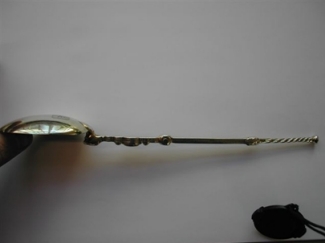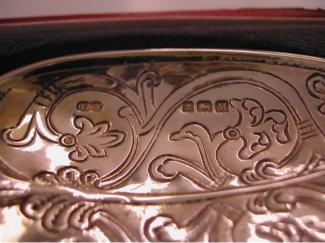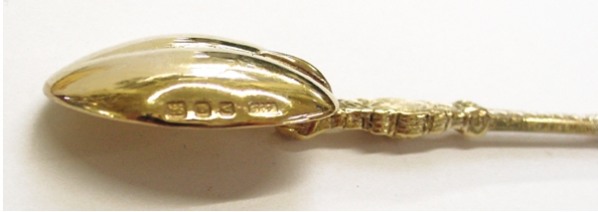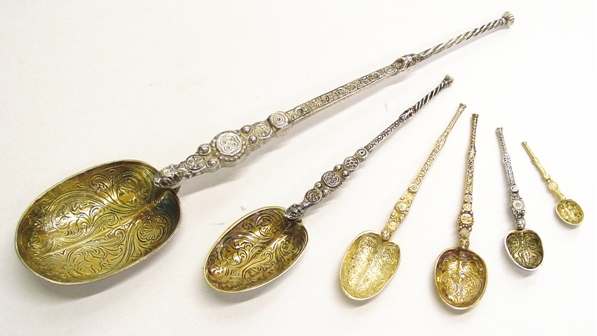 ASSOCIATION OF SMALL COLLECTORS OF ANTIQUE SILVER
ASSOCIATION OF SMALL COLLECTORS OF ANTIQUE SILVERASCAS
| article # 97 |
|
next |
previous |
(click on photos to enlarge image)ANOINTING SPOON REPLICAS IN SILVER AND SILVER GILT
|
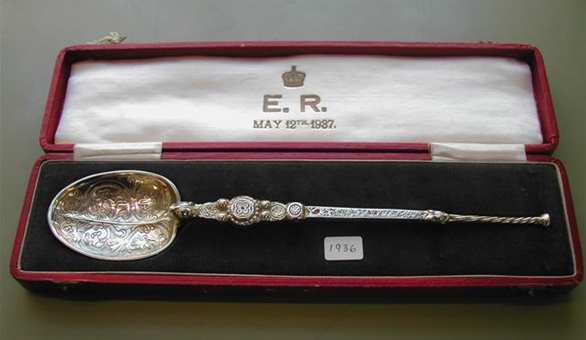 |
Spoon made and cased to commemorate the
Coronation of Edward VIII, which never took place.
|
I unknowingly passed on some of this chaff in my early days
of acquiring knowledge. Fortunately, I became acquainted with a
fellow collector named Barry Potter, who lives in Middlesex,
England. A true gentleman and scholar, he was able to pass on
some expert knowledge in this arcane field of collecting. He
also wrote a short article (from which I have borrowed for this
article).
Perhaps some of those whom I misinformed will have the
opportunity to read this little attempt at sharing somewhat
firmer knowledge.
Authorities agree that the oldest silver spoon known to be
English in origin is the Coronation Spoon, preserved among the
Crown Jewels in the Tower of London, and that it most probably
has been used in Coronations of British Monarchs since the 12th
or early 13th Century.
It is made of silver gilt, and is the only remaining piece of
the original Royal Regalia. Some of the other items of the
Regalia were disposed off by Charles I, the remainder were sold
or melted down at the time of the Commonwealth.
The Anointing Spoon was purchased and returned by the
purchaser at The Restoration. The spoon is 10 1/4" long,
overall, and weighs 3 oz.,8 dwts, decorated with four freshwater
pearls set in the widest part of the attenuated handle, which is
decorated with chasing up to its writhen top. Overall the design
predates Christianity. The thin bowl, which is joined to the
stem by a modified elbow depicting the head of a leopard, has a
central ridge, thus allowing two fingers of the anointing
archbishop to be dipped into the oil.
It is thought to have been rebuilt for the 1661 coronation, when
the spoon was re-gilt, and is decorated with an arabesque
pattern. It may be pointed out that, this, probably the most
valuable ancient English spoon in existence, does not possess
any authenticating marks.
Sterling silver and silver gilt replicas of the Anointing Spoon
have been manufactured for at least 134 years. They vary in
accuracy of replication as well as in quality. The early spoons
(1873-1909) are fairly consistent in both categories. Much of
this depends on when and by whom they were made. However,
beginning in 1910 some diminution in quality begins to appear in
design and production.
British hallmarks are usually London or Birmingham, but examples
also exist from Sheffield, Chester, Edinburgh, and Glasgow. The
locations of the hallmarks vary among the interior of the bowl,
its back, or on any face of the handle and can be difficult to
locate, as they often are hidden within the intricate design of
the bowl or handle.
Published pictures of the original spoon exist in coronation and
Crown Jewel books, but pictures of replicas are hard to find.
One such can be found of an 1883 spoon, hallmarked in London, in
Silver Flatware by Ian Pickford, and several pictures are in
Silverware of the World.
I have been unable to discover why the first replicas were made.
Their years of production do not necessarily coincide with any
major celebration connected with the Monarchy.
There have been some incorrect assertions made regarding
their manufacture and distribution.
First incorrect assertion: These spoons were created in
the coronation years during the twentieth century as
commemoratives of the coronations.
While it is true that they were made in the coronation years,
they also were made in practically every year (with some wartime
exceptions) since at least 1873, according to the Commemorative
Collectors Society in Great Britain.
My first acquisition came in a box with an advertisement for
four sizes of spoons. I decided to collect the four spoons for
each coronation in the twentieth century (based on faulty
information). That meant, I thought, a collection of sixteen
spoons. I soon discovered that this was not even a drop in the
ocean!
The earliest example in my own collection is dated 1885, sixteen
years before the death of Victoria and the accession of Edward
VII. Years of production represented in my collection and others
I know are as follows: 1873, 1885, 1886, 1899, 1900, 1901, 1902,
1903, 1904, 1905, 1906, 1909, 1910, 1911, 1923, 1927, 1935,
1936, 1937, 1951, 1952, 1953, 1954, 1955, 1959, 1960, 1961,
1962, 1966, 1970, 1971, 1978, 1995, 1997, and 2004. You will
notice the conspicuous break in production periods which
coincide with the two World Wars.
There often were some rather fine cases made during the
coronation years as commemoratives (I have run across many such
boxed sets, including a set of six spoons, made in 1936, for
teaspoon use, I assume, with the case marked for the coronation
of Edward VIII, which, of course, never took place).
The Anointing Spoon design was also issued in some interesting
variations: forks, pickle forks, toast racks, etc. Some of these
were cased, or somehow marked, as coronation commemoratives.
Second incorrect assertion: The spoons were made only by
English silversmiths.
In fact, I have spoons in my collection hallmarked in six assay
cities (Birmingham, Chester, Edinburgh, Glasgow, London, and
Sheffield), and I have and have seen examples from the European
Continent (most often Holland) and Canada.
The spoons I have seen from Canada frequently combine the design
of the Anointing Spoon with the addition of a specific
commemoration in the form of a medal at the end of the spoon
handle. Sometimes this takes the form of a profile head of the
newly-crowned Sovereign, along with his or her spouse (except
for Edward VIII), the Coronation Chair, a crest, or the
monarchís cipher.
Acknowledgements: Thanks go to my friend, mentor, and fellow collector, Barry Potter of Hayes, Middlesex, England, who provided invaluable and hard-sought material for this article. As a body of information, it is not found anywhere else, and I could not have found all of his sources on my own. His generosity in sharing this information is deeply gratifying. Mr. David Freeman-Valle, General Manager of Saunders Shepherd & Co Ltd., was most generous in his time and efforts in tracking down members of the firm who might have the information I requested and in providing and making some of the photographs. Mr. Tony Shepherd, Chairman of SS&Co, provided invaluable memories of spoon production. Mr. John Coupland, Managing Director of SS&Co, generously shared part of his private collection to be photographed. SS&Co provided photographs of spoons from their museum. Mr. James Deakin of Deakin & Francis, Ltd provided an anecdote and some photographs. I exchanged several emails with Craig Robathan, Proprietor of C. Robathan & Sons Ltd, Birmingham. He very kindly looked into their reco (If you have a request of them, please provide a photograph or drawing of the makerís mark). Thanks are due to those representatives of firms and organizations who responded to my requests for information with sincere regrets. So much valuable information has been destroyed or lost.
|
Jack F. Wilson - 2008 -
JACK FOWLER WILSON is a retired Episcopal priest
living in the southeastern United States in Alabama. His
enthusiasm for collecting these spoons comes from an
appreciation of fine craftsmanship and British ancestry
on both sides of his family.
|
